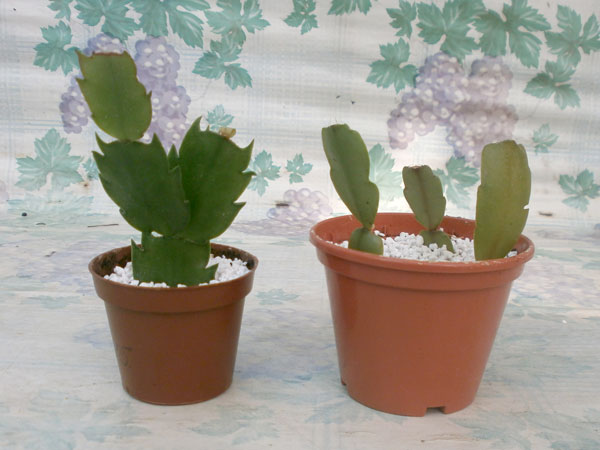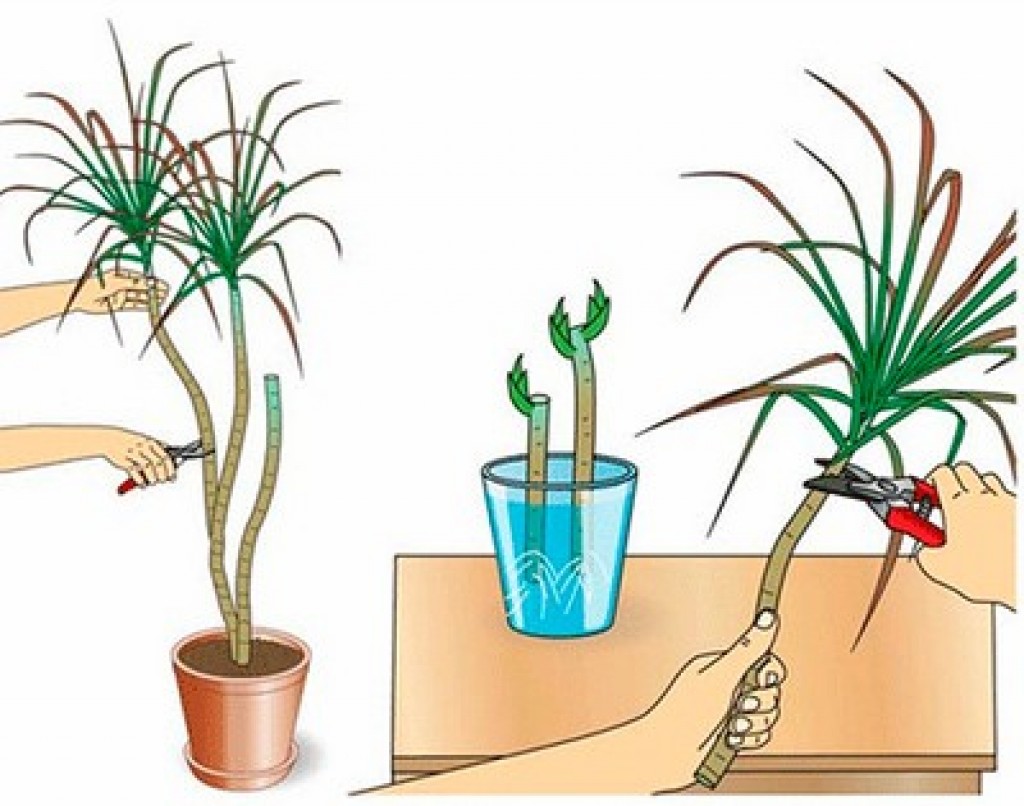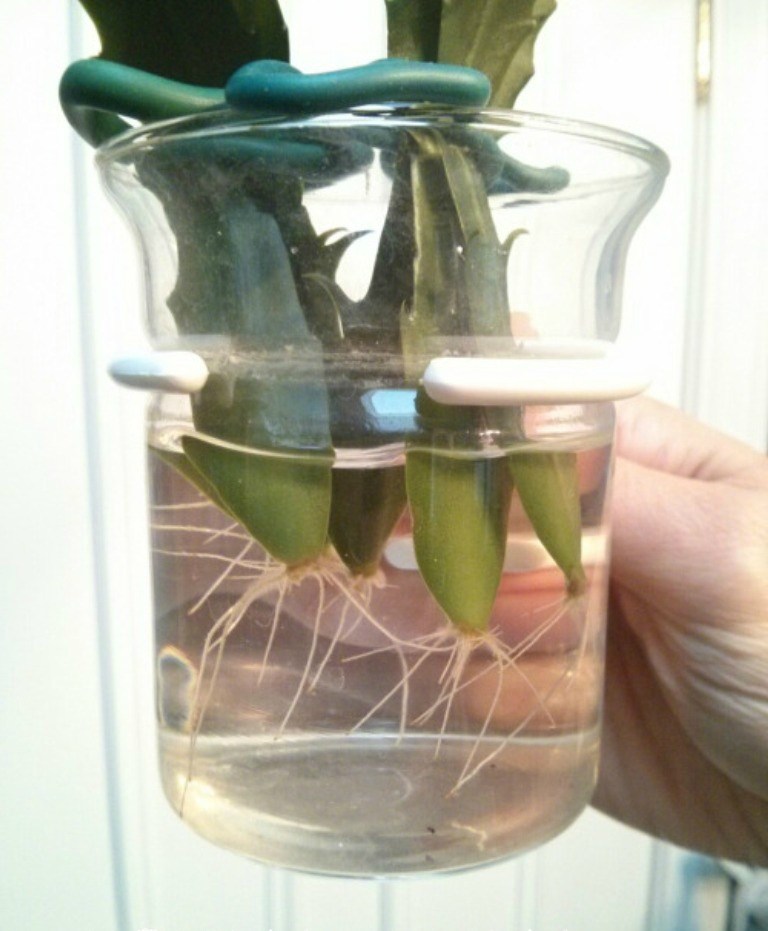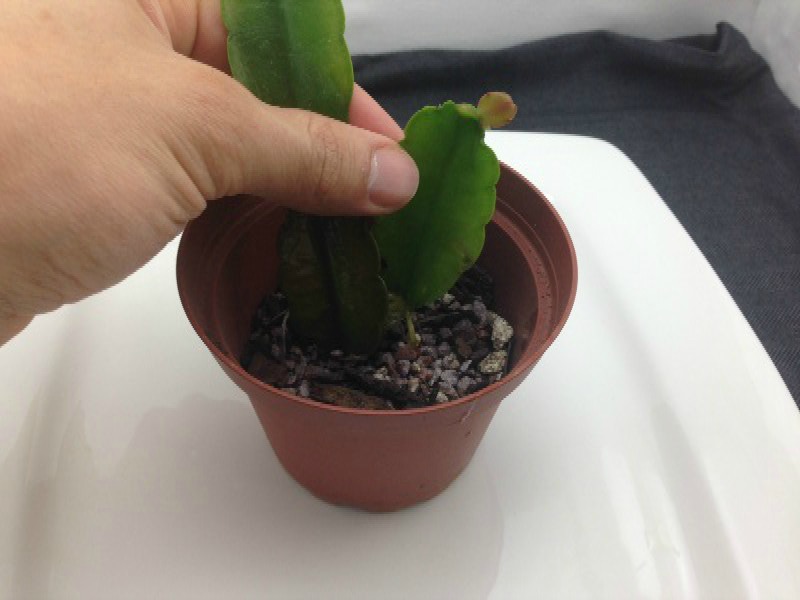Breeding tips
Despite the fact that caring for a Decembrist in most cases does not cause difficulties, there are still features that should be taken into account.
Several features of the Decembrist:
- As soon as the buds begin to form, the flowerpot with the plant cannot be moved, otherwise the inflorescences will crumble.
- Decembrist does not tolerate watering with water containing chlorine and lime.
- Spraying should be done with warm water.
- Excess water should not be allowed to stagnate, especially during the winter season.
- Top dressing is carried out with solutions of mineral and complex fertilizers; it is necessary to dilute chemical preparations stronger than indicated on the package.
- The Decembrist can be grown like a regular bush or ampelous plant.
With proper care, the Christmas tree grows and blooms profusely for 15 to 20 years.
Possible difficulties after planting the cuttings
1. Withers.
The most likely cause is a fungal infection - late blight or phytium. Another reason for the wilting of leaves is a disease of the root system. If the central trunk of the bush has become unstable, the roots may have died from watering with too cold water. Fertilizers could burn the root system. Regardless of the cause of wilting, the plant must be carefully dug up and, depending on the state of the root system, a further algorithm of actions must be chosen:
- cut off the damaged area of the roots, and plant the remaining healthy bush in a flowerpot, if the cause of death is fertilizers, the substrate is completely changed;
- if the root system has died completely, use cuttings for propagation of young plants.
2. The Decembrist does not bloom.
The Christmas tree has a calendar according to which the plant blooms. If the period of bud formation is not preceded by a rest period, do not expect the Decembrist to bloom. The rest period is as follows:
- from the second half of September, watering the Decembrist is reduced, they stop applying fertilizers and put the flowerpot in a cool room;
- at the end of November, the flowerpot is placed on a light windowsill and watering is gradually increased, as soon as buds begin to form, the plant stops moving and rearranging.
3. Leaves are falling off.
For many gardeners, especially beginners, a sharp fall of leaves comes as a surprise, since it is difficult to find the cause of the fall. From what a Decembrist can shed leaves:
- spider mite;
- lack of nutrients in the soil;
- insufficiently humid air;
- sharp temperature drop;
- draft;
- untimely transplant.
If you promptly identify the cause of the leaf fall, you can quickly eliminate the problem and return the Decembrist to its original healthy appearance.
Diseases and pests
Decembrist is a hardy plant, resistant to various diseases. However, improper conditions of detention can lead to dangerous fungal diseases.
Fusarium, late blight, phytium are fungal diseases that affect the root collar. The most likely route of infection is through the soil, where the infection can live for a long time. The infected plant becomes pale, becomes grayish, withers, individual segments fall off. The bush is treated with special preparations - "Vitaros", "Topaz".
Among the pests, the most dangerous for the Decembrist are mealybugs and spider mites. The worms form white lumps on the plant, similar to cotton wool. They can be easily removed with a cloth dampened with alcohol. If this procedure is ineffective, you can purchase a special drug at the flower shop.
A spider mite braids a plant with a thin web, and a pest is found along it. An effective drug against insects is the drug "Actellik".
How to care for a Decembrist flower at home
Schlumberger is an unusual type of cactus.It blooms in winter, does not like high temperatures and bright sunlight. Therefore, the conditions for its maintenance are fundamentally different from the conditions for growing other cacti and succulents. There are certain rules on how to care for a Decembrist so that it blooms and has lush and healthy stems.
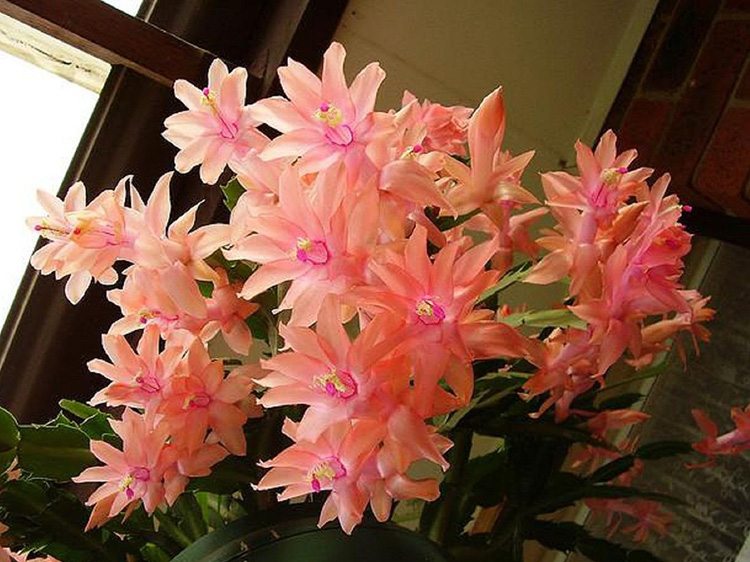
Lush bloom depends on the conditions of detention
Growth temperature conditions, location determination
The Decembrist, like other representatives of zygocactus, cannot stand exposure to direct sunlight. However, the plant needs good lighting. Therefore, for the location of the Decembrist, it is preferable to use window sills on the east side of the room. In summer, the flower can be placed outdoors or on a balcony.
Temperature conditions should be chosen depending on the periods of plant development. Active growth (vegetation) occurs during the warmer season - from April to September. During the growing season, the flower needs free access to oxygen, the ideal temperature for it will be + 20 ° C.
In the fall, Schlumberger freezes to prepare for flowering. Incorrect content is the reason why the Decembrist does not bloom at home. For a comfortable stay, the flower needs to create conditions of coolness and low humidity. If in the summer the plant was kept in the air, then in the fall it can be left in the same place, keeping the temperature not lower than + 12 ° C, the temperature in winter - from + 16 ° C to + 22 ° C.
What land is needed for the Decembrist
Before planting a Decembrist, you should prepare high-quality soil for it. Schlumberger is a representative of the epiphyte species that naturally grow on other plants. Accordingly, the soil must freely pass moisture and air. The soil mixture is made up of leafy earth and sand in equal parts. For better flower nutrition, peat or charcoal is added to the mixture. Packaged soil for cacti, sold in stores, will not work, since it contains an excess amount of peat.

Soil for cacti is oversaturated with peat
Decembrist transplant rules at home
How to transplant a Decembrist at home so as not to harm the flower? It is recommended to do this after flowering in early spring. For the first few years, shoots are transplanted every spring, then every 3 years. The new pot should be 2 cm larger than the old one. One third of it is filled with drainage. To improve moisture permeability, fine expanded clay is added to the soil mixture. A tall pot is not required for Schlumberger, as it has superficial roots.
How to water the Decembrist, depending on the season
Unlike other cacti that can be watered infrequently, Schlumberger needs regular watering. However, you cannot fill the flower, as its roots can rot. Water it with soft water at room temperature.

Spraying removes dust on the stems
During the growing season, watering is needed moderate. The Decembrist must be regularly sprayed with warm water so that the plant feeds on moisture, and the stems are cleaned of dust.
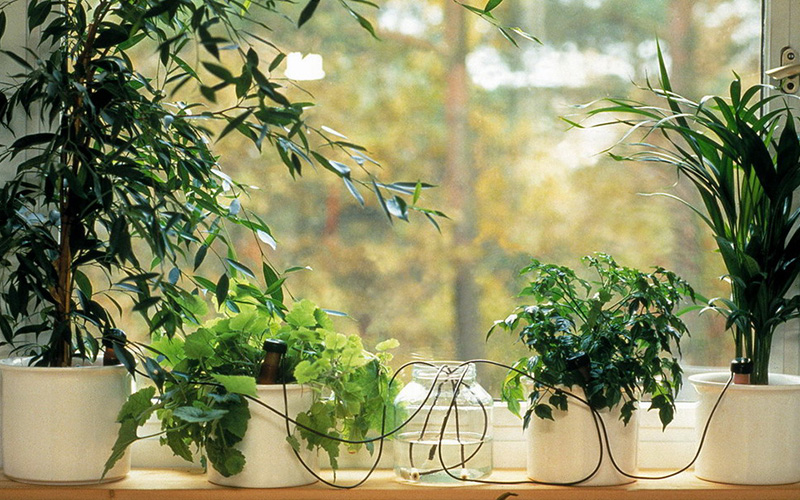
Catalog of indoor flowers with photos and their names. In a special publication of our portal, we will tell you in detail about indoor flowers. You will learn about the types of indoor flowers, fruit indoor flowers and see the photo gallery.
Reproduction
Schlumberger propagates only by cuttings. Start the event in early spring, when all the Decembrist buds are gone. You can combine this event with the formation of the crown.

How to propagate zygocactus:
- For cuttings, choose strong shoots with 2-3 segments and twist them out by hand. Be sure to dry them for 2-3 days before planting.
- Fill 100-200 ml pots with soil with the same composition as for adult plants.
- Water the substrate abundantly and plant the cuttings in it to a depth of 1 cm.
- Cover the planting with foil or glass and place it in a place out of direct sunlight.
- Maintain a temperature of + 15… + 20 ° C near the greenhouse. Remember to air the planting daily and regularly spray the soil with warm water from a spray bottle.
- When the cuttings take root and get stronger, remove the shelter.
After six months, transplant the young plants into individual pots up to half a liter in volume. In the future, provide the flowers with the usual home care. Reproduction of the Decembrist flower, as you can see, is a simple process. The main thing is to adhere to the recommendations, and the cuttings will definitely take root.

Reproduction
- Cuttings. The broken-off segments are dried for 2 - 3 days. Then simply stick the stalk into damp ground for cacti or orchids. For better rooting, a small amount of root is introduced. After planting, the pot is covered with a transparent film and, regularly airing, the next segment is expected to appear. The film is then removed and cared for as an adult Schlumberger.
- Vaccination. For this, use another cactus. He either cut off the top, insert and tie (pin) a Schlomberger segment into it, or make a lateral incision and carry out the same procedure.
- Seeds. This requires two flowering plants. On the second day of flowering, pollination is carried out with a brush or cotton swab. Ripening of seeds in fruits lasts 6 - 8 months. After the fruit has become soft, it is plucked and the seeds are removed. Treated with a solution of potassium permanganate, the seeds are sown on wet soil. After 6 - 8 weeks of growth, a pick is carried out. In the first year of life, they are transplanted every three months, in the second year, they are transplanted three times. A Christmas tree obtained in this way is considered an adult only after two years of growth.
Important! Starting from the second month of growth, without fail, feeding with half the dose fertilizer for cacti and sprayed with an aqueous solution of ammonia (a teaspoon for two liters of water).
If an amateur florist adheres to those simple rules of care and cultivation at home, which require a Schlumberger, then as a result a small cactus from several small segment segments will turn into a luxurious branchy plant that will delight with its large flowers every winter. Now you know how to raise a Schlumberger.
You can find out how to propagate a Decembrist flower at home here.
Preparing for planting
The success of growing the Barbarian scythe depends on the correct planting. How to plant a crayfish neck, read on.
Did you know? According to popular beliefs, Schlumberger — it is a flower that absorbs and transforms evil energy and transforms the atmosphere in houses into a positive direction.
Optimal conditions and choice of location
The Schlumberger cactus migrated to us from tropical countries - Brazil and South America. In its natural environment, it grows on the rhizomes and trunks of tropical plants. Due to the fact that the tropics is an area with an abundance of dense greenery, the zygocactus have adapted to live in shaded conditions.
The Christmas tree does not welcome direct sunlight, which can burn the sensitive leaves of the crop. The best place for a flowerpot will be a corner remote from the window, which, if necessary, will need to be shaded. During the flowering period, the Schlumberger will feel great on a shelf, closet or wide windowsill. The main thing is to make sure that the flowerpot has enough space, and its stems are not crowded.

Despite its tropical manners, the flower is well acclimatized in indoor conditions. It does not require narrow temperature restrictions: it feels great in the temperature range of + 10 ... + 35 ° C. But at the same time, you should not test it with abrupt changes in climatic conditions, for example, take it out of a warm room onto a cold balcony. Preparation for changing temperature regimes should be moderate.
The Decembrist is demanding on the humidity of the environment.He will feel bad in dry air, and during the budding period, future flowers will begin to fall off, therefore, an air humidifier, a tray filled with expanded clay stones, or at least a wet towel must be placed near the flowerpot.
Important! Christmas shoots need regular spraying from a spray bottle (2 times a week). In this case, it is worth covering the soil with a polyethylene film so that water does not fall on the ground.
Also, make sure that the flower does not coexist with heating devices.
Choosing a container for planting
Florists who want to settle a Varvarin flower in their home are often worried about the question of which pot is needed for planting. The Schlumberger cactus has a small rhizome, therefore, the size of the container for planting it should be small. This is the case when the width of the pot must be greater than the height. As for the material, it is best to take clay or ceramic containers.
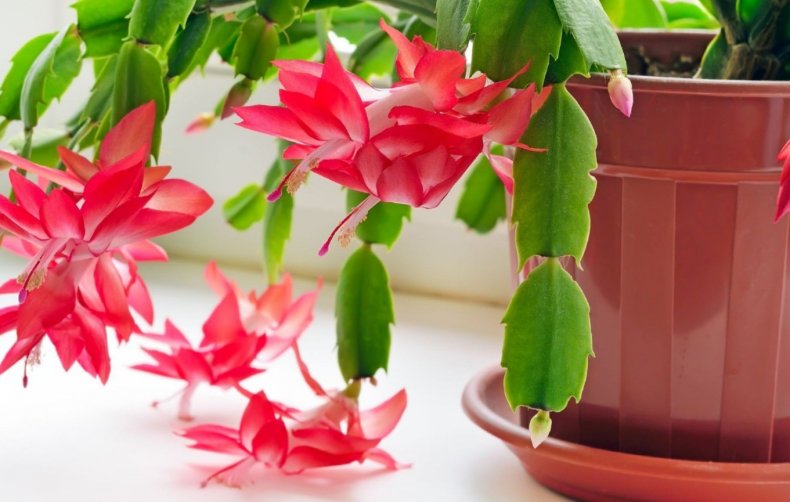
You can also use plastic ones. The main thing is to take care of good drainage of the pot: the container can be purchased with ready-made holes or you can drill them yourself. As the flower grows, it will need to be transplanted and, accordingly, a larger pot must be selected.
Soil preparation for planting
The ideal substrate for a Christmas tree is the cactus potting soil available in every flower shop. The main requirements of the Decembrist to the substrate are looseness, high nutritional value, good air and water permeability. If desired, the required soil can be prepared independently by mixing turf and leafy soil with peat and coarse river sand or brick chips, the required proportions are 1: 1: 1: 1.
Important! The optimal soil acidity index for zygocactus is 5.0–6.5 pH.
To prevent moisture from stagnating at the roots of the plant, it is recommended to add a little perlite and wooden bark (preferably oak) to the prepared soil. Before planting, the substrate must be disinfected. It is advisable to warm it up in the oven (about 10 minutes), steam it in a water bath, or pour it over with a light pink potassium permanganate solution. You can also carry out disinfection by mixing the prepared substrate and crushed coal.
Description of the plant
Schlumberger is a special genus of cacti native to the rainforests of South America. It was introduced to Europe at the beginning of the 19th century and since then has been successfully used as an ornamental indoor plant.
In the countries of the former USSR, this flower is also known under the names "Decembrist", "Decembrina", "Rozhdestvennik", "Christmas cactus" and "Zygocactus".
Did you know? Federic Schlumberger is a renowned cactus collector who lived in Normandy in the 19th century. His name was given to the beautifully blooming succulent in 1858 by another Frenchman - Charles Lemaire, a botanist and writer, who had been preparing materials for a large-scale book about cacti all his life, but never realized the plan to publish it due to poverty and lack of a sponsor.
Zygocactus is an epiphyte plant. This means that the root system of this succulent is very weak and superficial, therefore, the flower receives all the main nutrients and energy with the help of aerial roots and through photosynthesis, using the moisture in the air.
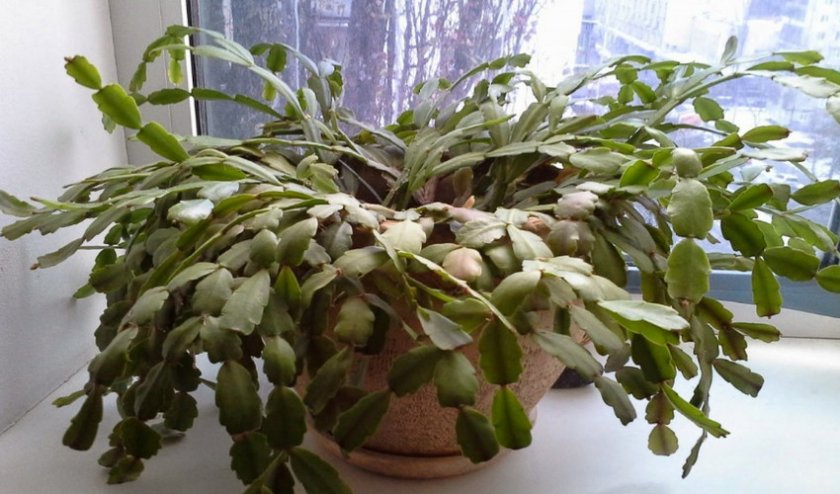
In thickened tropics, this ability allows the cactus to compete with other, more powerful plants and, using them as a support, stretch closer to the light.
The Decembrist, like other cacti, has no leaves. Their function is performed by numerous bright green stems, forming in the form of a lush bush and representing long and flat drooping chains, as if assembled from several successively connected fragments-cells measuring about 2 × 3 cm with jagged edges.
Wild varieties of zygocactus have thorns, but most hybrids of indoor plants are deprived of such "decoration".
At home, zygocactus can grow up to 40 cm in height, and decoratively falling stems allow you to grow a flower not only on window sills, but also in hanging pots (ampel method).
Christmas flowers bloom in several tiers at the top of the stems, 1-3 on each. In shape, they are a slightly curved tube with wide petals and far protruding pistils.
Find out more about how to properly plant and care for a Decembrist at home.
The sizes of the flowers are quite large, and the color can be different: the natural shades for zygocactus are red and white, but among the hybrids bred by breeders there are plants with pink, yellow, orange and purple flowers.
Schlumberger received its popular names due to the most characteristic flowering time for it. If in Brazil this process occurs in summer, then in the northern hemisphere, the cactus usually begins to bloom in the winter months.
However, experienced flower growers claim that with good care, the plant can please with the appearance of flowers at any time, and sometimes twice, or even three times a year.

What pot is needed for a zygocactus: description and photo
The Decembrist, also called zygocactus, is an unpretentious plant, but it is still necessary to observe some conditions for caring for it. First you need to choose a pot in which the Decembrist will grow. You can choose a standard earthen vessel, a plastic pot, or even an enamel bowl
It is important that the container for the plant has a wide radius and stability, but at the same time it is not too bulky.
The root system of the Decembrist is miniature; it does not need huge containers. After buying a plant, it must be transplanted at home, because the soil intended for transportation is not suitable for the planned and healthy growth of the Decembrist, or for its flowering.
In a pot that is too large, the Decembrist will constantly increase the root system, and you can forget about flowering during this period.
It is important to choose a small but wide container that will be ideal for the plant. Below you can see a photo of pots suitable for planting a plant:
Below you can see a photo of pots suitable for planting a plant:
What periods does the plant go through

Active growth
Decembrist is actively developing from March to September. The root system increases significantly in size. Fresh air is required during this period. It is possible to use both window sills and warm balconies and loggias. If possible, the Decembrist should be placed under a lush tree, provided that the daytime temperature is + 20 ° C and above. As the soil dries up, regular watering is carried out throughout the summer. Excess moisture or its stagnation should be avoided, since the cactus does not like this. Fertilizers and fertilizers are used to accelerate growth and are applied every few weeks.
Recreation
The whole October is allotted for this plant. Growth during this period is inhibited, as new buds are being laid. The length of daylight hours is getting shorter, as well as the need for frequent watering fades into the background. The temperature regime should be 12-19 ° С. The plant remains in the same place (balcony, meadow, windowsill) until the end of the period.
The trick to increasing the number of buds is to irrigate not with ordinary water, but with tea leaves. After such manipulations, even those representatives who have not released their buds for the last few years begin to bloom. As top dressing, formulations used for flowering plants are used, which are applied at the end of the month.
Abundant flowering period
This stage in the life of the Decembrist drags on for two months and lasts until January.The plant is in a warm room, in which the temperature is 16-19 ° C. Watering is plentiful, but not frequent. The settled water should be replaced with not strong tea without fillers and flavors. Phosphorus and potassium compounds are used as top dressing. For the development of strong and healthy buds, then you should use egg tincture or calcium nitrate. After the first buds appear, the pot should not be rearranged or turned.
Stasis
It lasts no more than a month and is interrupted with the onset of March. The time has come for the formation of the Decembrist bush. It is not recommended to remove the upper segments, they are carefully unscrewed. Otherwise, branching and increased density may begin
During this time, you should often pay attention to the surface of the soil, which should not dry out
The mistakes of novice gardeners lead to the following consequences:
- Termination of the flowering of the Decembrist for an indefinite period. It is a consequence of the lack of compliance with the correct temperature regime. An improperly selected soil mix will give the same result.
- Fragile buds are rapidly crumbling. Says that the pot was often rearranged or twisted. Watering conditions may not be met. It is impossible to stop the bud shedding process.
- Segments begin to blush rapidly. The plant is simply frozen over. If the ambient temperature drops below + 5 ° C, the plant begins to turn red. To change the current situation, the plant is transferred to a heated room.
- Darkening of the segment and subsequent wrinkling. The reason lies in the irrigation, which was carried out incorrectly. Both excessive and insufficient watering leads to this. If no measures were taken to change the situation, the roots of the plant will begin to rot.
Preparatory work
Since we are talking about an epiphyte, the choice of a pot for such a succulent is not of fundamental importance. However, a deep capacity in this case is an unfortunate choice, since the space free from the plant root system is always associated with an additional risk of the development of various pathogenic microflora.
For the same reasons, heavy soil is not suitable for zygocactus. The substrate should be loose and light, with good moisture and air permeability. Low acidity of the soil (pH level in the range from 5 to 6) is preferred.
It is best for beginners to purchase ready-made soil marked "for cacti" or "for succulents." However, this mixture needs to be improved a little.
In order for the soil to be as close as possible to the natural features of Schlumberger, the purchased substrate must be diluted in a 2: 1 ratio with a specially prepared composition:
- peat - 2 parts;
- chopped sphagnum moss - 1 part;
- broken expanded clay - 1 part;
- sand - 1 part.
More experienced growers can prepare the substrate for planting zygocactus on their own by mixing:
- leafy ground - 6 parts;
- sod land - 1 part;
- humus - 4 parts;
- peat - 2 parts;
- coarse river sand - 2 parts.

The easiest way to do this is by placing the material in the freezer overnight (or exposing it to the balcony if the night outside temperature drops to at least –10 ° C), then keep it warm for 12 hours and freeze it again.
You can also warm up the substrate for several hours in an oven heated to + 70 ° C (at a higher temperature, beneficial soil bacteria die, which impoverishes the earth), or simply pour abundantly with a saturated pink solution of potassium permanganate.
Did you know? A rather unusual, but well-proven method of preparing soil for zygocactus is to use a substrate for orchids as a base.Since such a mixture does not contain soil at all and contains only dried fern roots, sphagnum, tree bark and charcoal, it is mixed in equal parts with deciduous humus.
Finally, to plant the Schlumberger you will need expanded clay, fine gravel or other material that will provide a reliable drainage layer in the pot. This is necessary to prevent stagnation of water in the soil, which the zygocactus, like any other succulent, does not tolerate at all.
Reproduction methods
There are several ways to breed a Christmas tree:
- cuttings;
- vaccination.
The most affordable and effective way is grafting. Breeding a Christmas tree with a scion is a much more difficult task, but it is also available at home.
How to propagate the Decembrist by cuttings
1. Time for breeding.
Zygocactus cuttings root perfectly regardless of the season and weather outside the window. But it is best to do the breeding of the Decembrist in the period from April to May. At this time, the mother plant has already bloomed.
2. Choice of cutting.
Healthy, undamaged cuttings from three separate elements are suitable for propagation by a leaf. It is necessary to inspect the plant and select a separate shoot with small roots. If you want to grow a lush bush, you need a few cuttings.
It is preferable to choose shoots on a less dense part of the plant, this is due to the fact that after cuttings the adult plant rejuvenates, and in the place of the cut off shoots others will intensively begin to grow and bloom profusely.
3. Separation of the cuttings from the mother plant.
Never use a knife, scalpel, scissors, or other sharp object to cut off the appendix. Use only your hands. Take the handle, pinch it a little and twist it around the axis. Hold the plant with your other hand so as not to accidentally break it.
4. Preparing the cutting for planting.
The shoots need to be dried, for this they are left in a container for a day in a dry and dark room. A transparent film forms at the site of separation - this means that the plant is ready for planting. If possible, cuttings can be sprinkled with sand or charcoal.
5. Preparing the soil.
The easiest way is to buy a universal cactus soil in a specialized store. The acidity of the soil should be in the range of 5.5-6.5 pH.
You can also prepare the substrate yourself. The optimal composition of the soil for the Decembrist:
- leaf land - 6 parts;
- humus earth - 4 parts;
- peat - 2 parts;
- sand - 2 parts;
- sod land - 1 part.
Zygocactus grows best in the soil, which is enriched with peat, so some growers grow the Christmas tree in pure peat. The two main conditions that apply to the substrate are lightness and breathability.
Note: a third of the flowerpot is filled with drainage to avoid stagnation of water in the flowerpot.
6. Planting cuttings.
The size of the flowerpot should not greatly exceed the volume of the root system. The roots of the zygocactus are poorly developed, so there is no need for a large pot. The pot is filled by a third with drainage, and up to half with a prepared substrate. The soil is lightly pressed and moistened. A recess is made in the center, and a shoot is planted. If you need to plant several cuttings, the grooves are made according to the number of plants.
If it so happens that it is time to plant the shoots, and you have not yet had time to purchase the flowerpot, use disposable cups. Cover the top of the plant with a glass container or polyethylene.
7. Growing conditions.
The container is immediately placed in partial shade and the temperature is maintained from +15 to +20 degrees. Plants need to be regularly ventilated - the shelter is removed daily for 20-30 minutes. Watering is necessary in moderation.
For full rooting, a Christmas tree needs 3 to 4 weeks. As soon as new segments of leaves appear on the cutting, it is transplanted into a permanent flowerpot.
Reproduction by grafting
This technique is unpopular and rarely used. If you want to experiment, master new techniques of floriculture, try to plant a Decembrist. Two plants are suitable for this:
- prickly pear;
- pereskia prickly.
The upper part of the prickly pear or pereskia is cut off, the stem is removed from the leaves and is split closer to the upper edge. 2-3 Decembrist segments are used as a scion, the lower part must be sharpened and inserted into the prepared slot. After that, the vaccination site is fixed with a needle and a plaster. Plants grow together at a temperature of +18 degrees for several weeks.
The bandage can be removed as soon as the plant begins to grow. All lateral shoots and leaves on the plant to which the Decembrist was grafted must be removed, otherwise the rootstock will not have enough strength to provide the grafted stalk with nutrients. If the grafting process is done correctly, the Decembrist will bloom in the very first winter.
Flowering period of the Decembrist

A plant completely covered in gorgeous flowers is a beautiful, joyful sight. However, without some care, it will be very difficult to achieve the flowering of the Decembrist. The main thing is to properly prepare the zygocactus for the flowering period.
In order for the bush to bloom profusely, it should be grown in a narrow-shaped flowerpot.
In a room with cool air, flowering will last.
When the Decembrist blooms, it is strictly forbidden to expose him to unexpected temperature changes.
During this period, gardeners are not advised to prepare cuttings for propagation and somehow move and rotate the flowerpot where the zygocactus grows
A dormant period will encourage more bud formation.
In winter, use an additional light source.
The temperature regime is not higher than +16 degrees, this contributes to more active flowering.
During August, it is necessary to completely exclude soil fertilization, spraying of the plant, and watering should be reduced to the possible minimum.
Then watering, feeding can be resumed, but extremely carefully and warningly. The plant can always shed even almost opened buds.
When purchasing a blooming Decembrist, one should expect that some of the flowers will fall off. This is a natural process that cannot be prevented. The plant adapts to unfamiliar surroundings.
Propagating the Decembrist
How does the Decembrist reproduce at home? Cuttings. Blooming Christmas tree in winter. By the spring, he begins a new growing season. This is the time for grafting.
It is best to separate the cuttings at the end of flowering. Schlumberger has air roots. For grafting, a stalk with a pair of shoots is found and unscrewed. Do not use a knife or scissors to separate the sprout.
The segment is taken with two fingers and slowly rotated. The escape will painlessly separate from the mother. After separation, the stalk needs to be dried. It is left in the air. The process lasts from two hours to two days.
Attention should be paid to how to root the stalk. Dried sprout should be planted in sand or its substitute, for example, in perlite
Having planted the shoot, they wait for the roots to appear.
It is also permissible to stimulate root growth in water. Then you need to add root to the liquid - a means that accelerates the development of the root system. After about four weeks, a new segment will appear on the scion. The rooting went well, the cutting can be planted in the main soil.
Reproduction of the Decembrist by cuttings is possible under banks. In this case, the shoots are immediately planted in the main soil, but covered with small transparent jars. A kind of greenhouse is formed on the windowsill. From the moment of planting to the emergence of the sprout from under the can, it takes about the same time as when planting in the sand. The signal of well-being will be the same new segment.
Reproduction by grafting
There are still ways how to propagate the Decembrist at home. This is a vaccination. Vaccination is rarely used.It is used mainly for the purpose of stamping - getting a new crown shape.
When propagating by grafting, the top of the flower, on which they are going to graft a new sprout, is cut off with a sharp knife. The remainder of the stem is split with the same knife. Get a small hole. A previously prepared Decembrist segment is inserted into the hole.
A segment should have several segments. The graft is tied with a thread or rewound with a strip of soft tissue. The bandage is left until new shoots appear on the grafted shoot.
After that, the dressing is no longer needed: it is removed, and the leaves growing close to the graft are removed from the mother's trunk. The grafted plant should be tied to a peg. This will help avoid breaking off.




